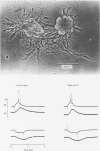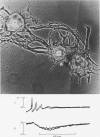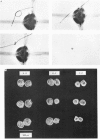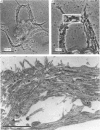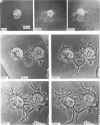Abstract
1. Individual, identified neurones, dissected from the central nervous system of the leech and maintained in culture for several weeks, sprouted processes and formed synaptic connexions.
2. The action potentials of isolated touch (T), pressure (P), nociceptive (N) cells and Retzius cells resembled those of their counterparts in situ, enabling them to be recognized unambiguously. Their input resistances were approximately 4 times greater than those of corresponding cells within the animal. In T, P and N cells trains of impulses were followed by a pronounced after-hyperpolarization, as in the animal.
3. In certain cells, notably the L motoneurones, membrane properties became altered in culture. The current—voltage relation showed novel rectification and action potentials became much larger.
4. Numerous neurites often extended for hundreds of micrometres from isolated neurones and ended in typical growth cones. Electron micrographs revealed that many fine axons were braided together to form thicker fascicles. Frequently, the processes were orientated between two neighbouring cells rather than at random. The fine structure of the cytoplasm, nucleus and organelles in cultured cells resembled those of their counterparts in situ. The glial cell that normally surrounds the neurones was, however, absent.
5. Pairs of Retzius cells in culture usually became coupled electrically after about 6 days. Similarly L motoneurones became coupled in vitro. These junctions allowed current to pass in both directions and resembled those seen in the animal.
6. Selective connexions were made by certain types of cells. Thus, P sensory neurones did not become coupled with Retzius cells but did develop electrical connexions with L motoneurones, as in the animal.
7. Novel synaptic interactions not obvious in the animal could appear in culture. Retzius and L cells became electrically coupled and, in some instances where electrical coupling between Retzius cells failed to develop, chemically mediated inhibitory potentials became apparent.
8. Isolated, identified leech neurones not only survive but regenerate processes and are capable of forming selective connexions in culture. The ability to define interactions between isolated pairs of cells offers the opportunity to explore in detail problems relating to synapse formation and cell—cell recognition.
Full text
PDF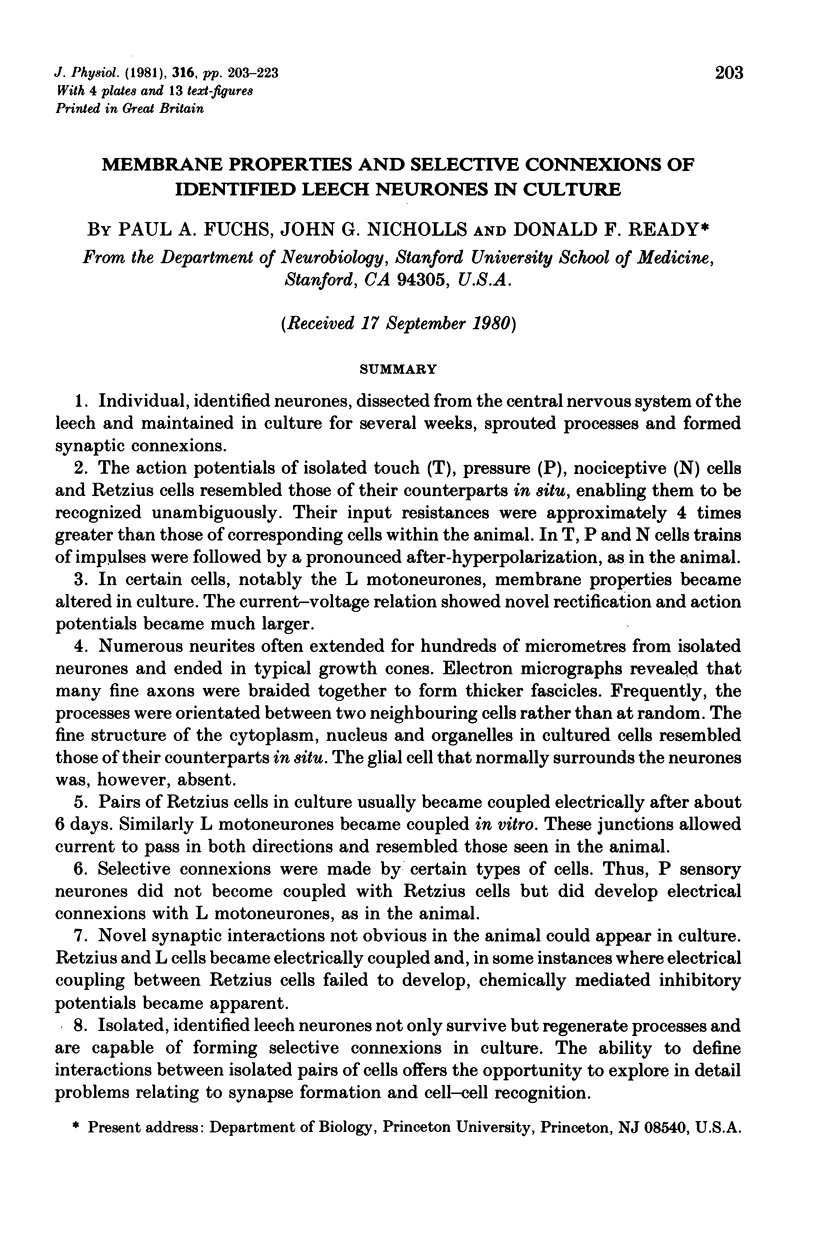
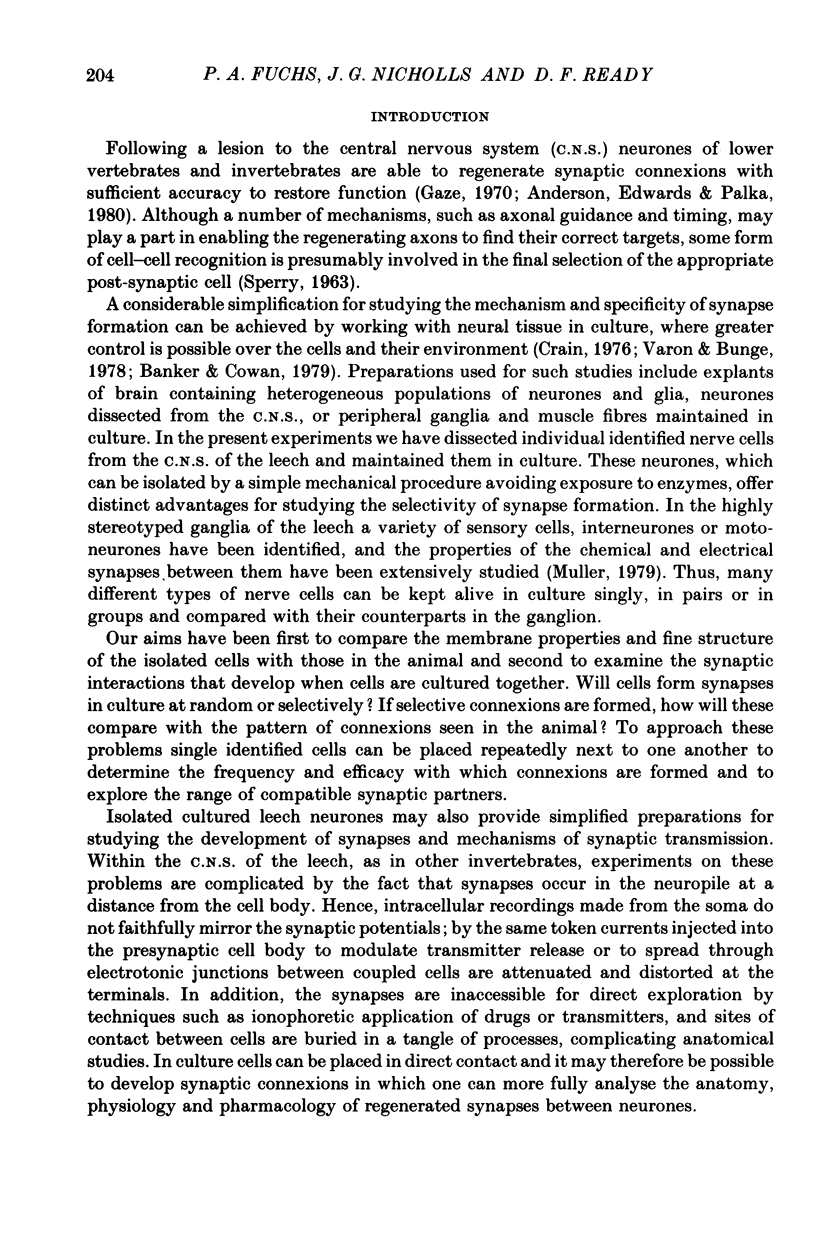
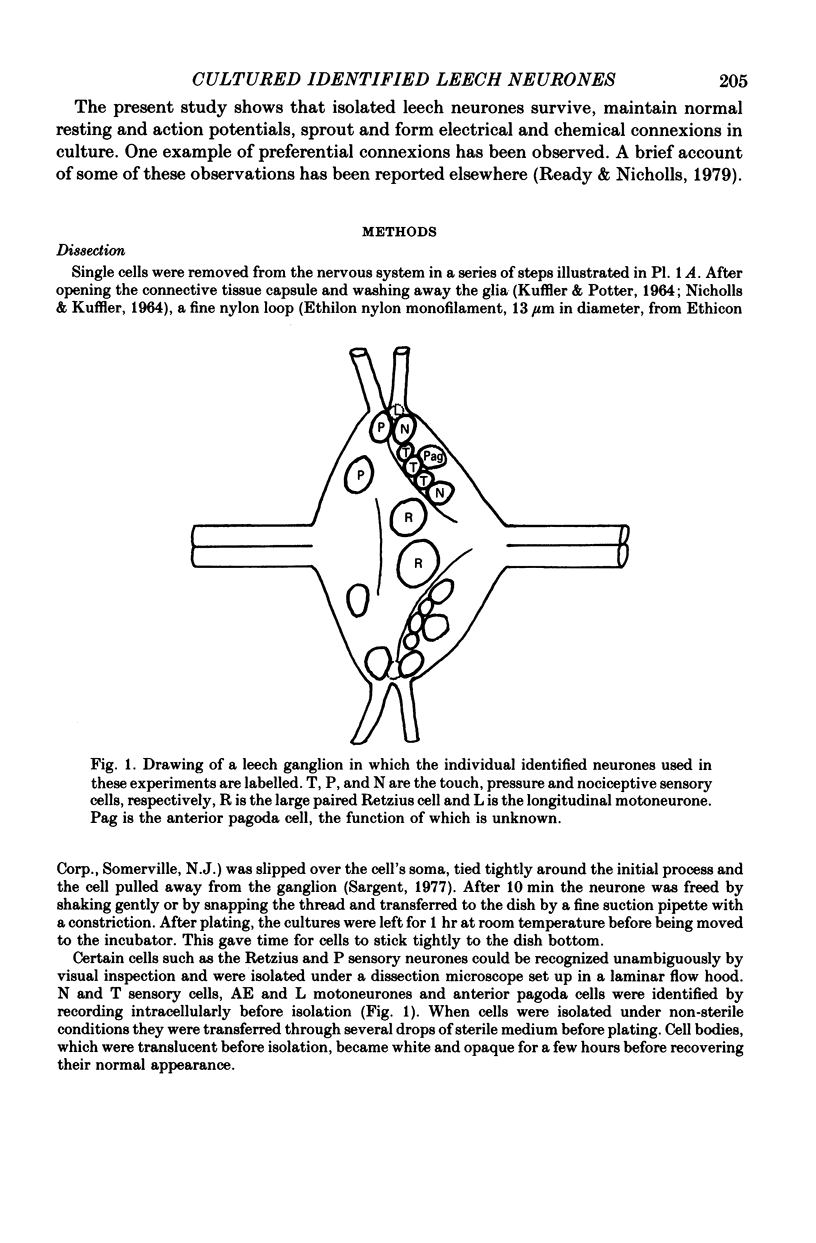
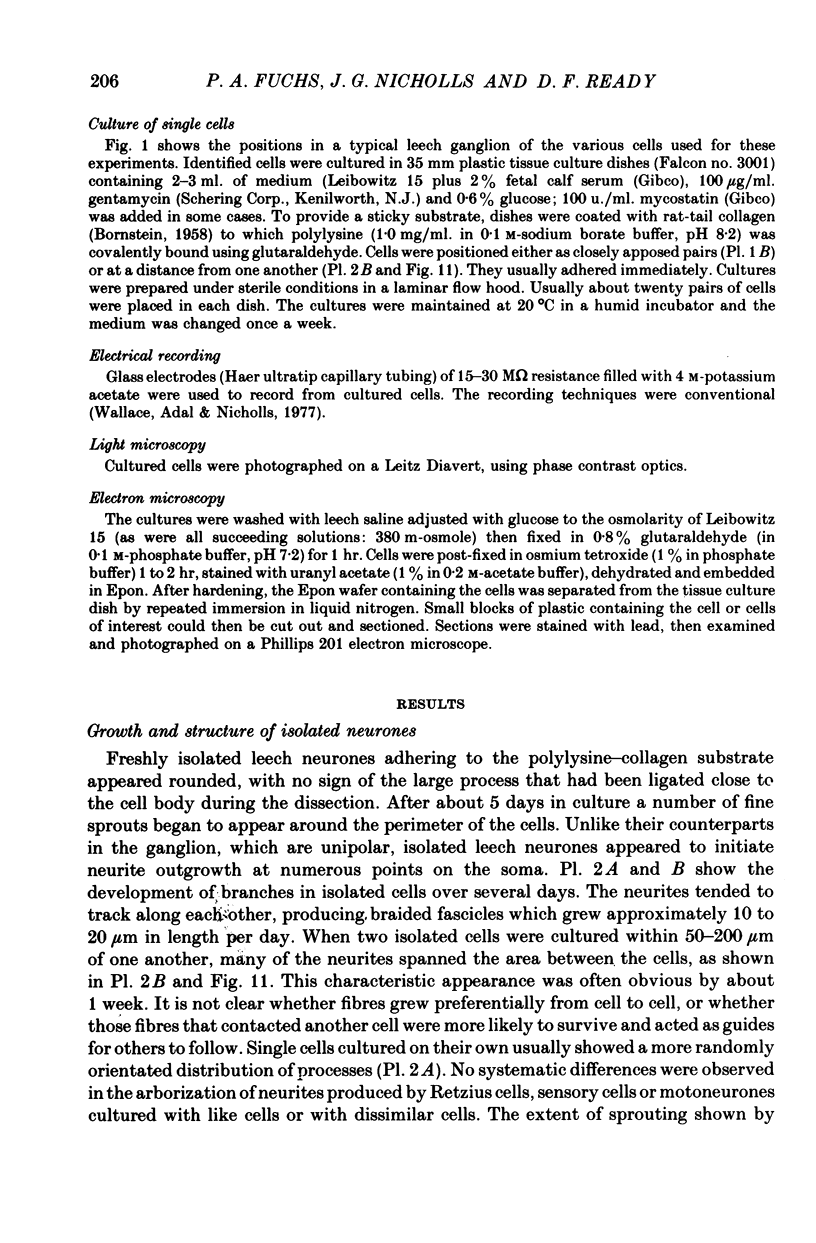
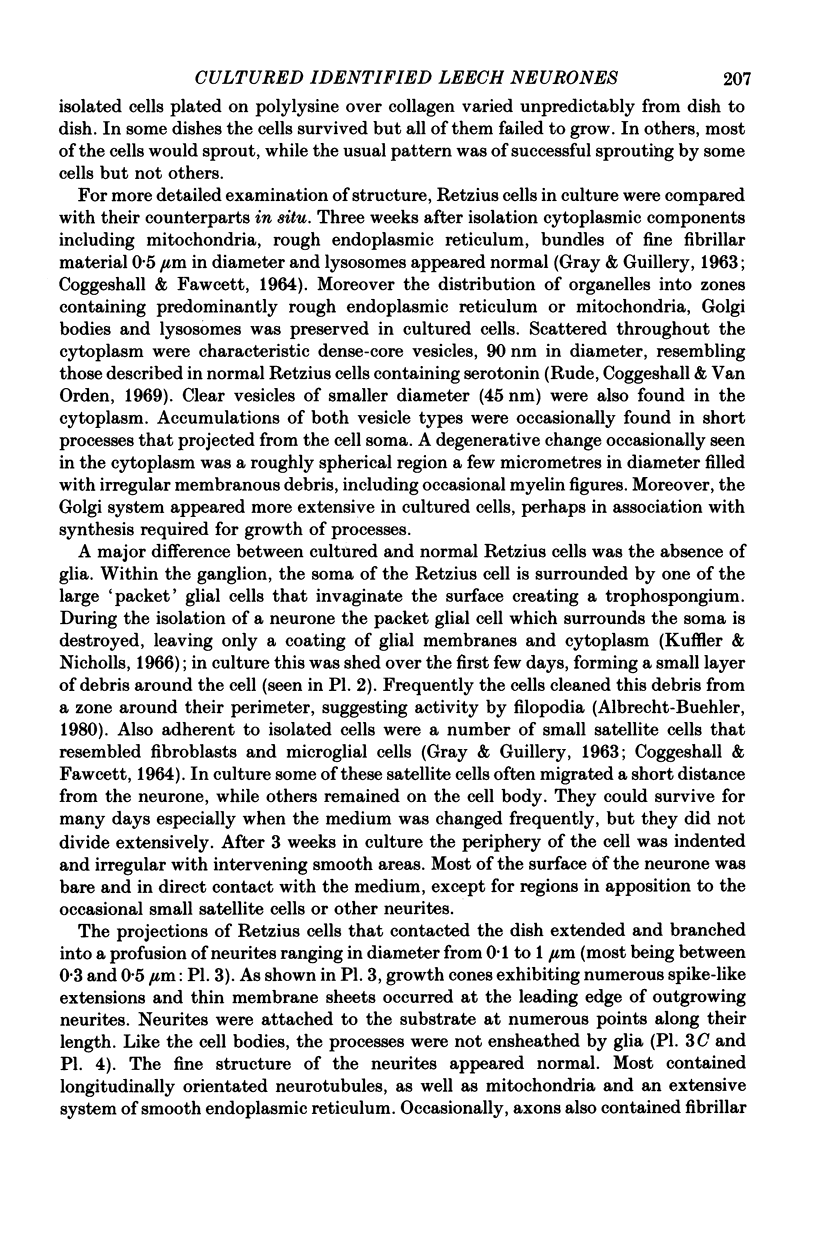
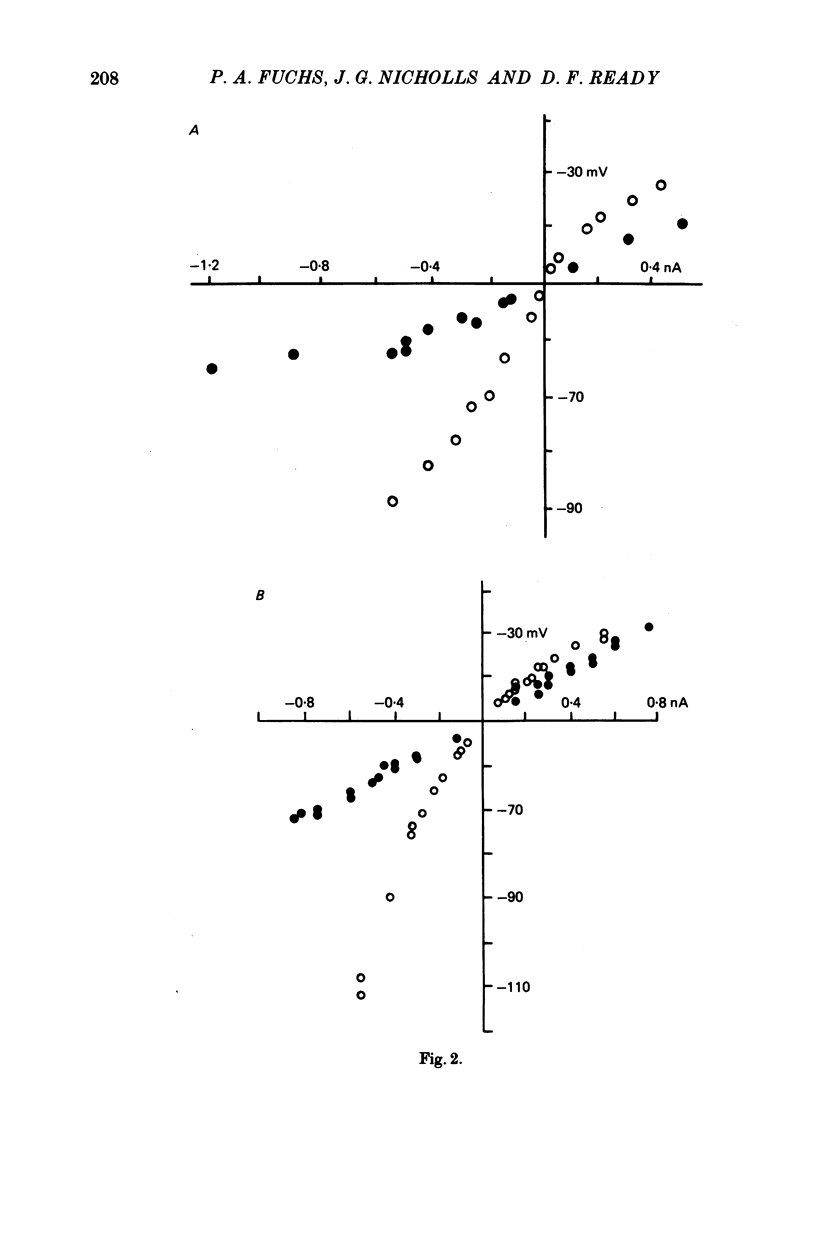
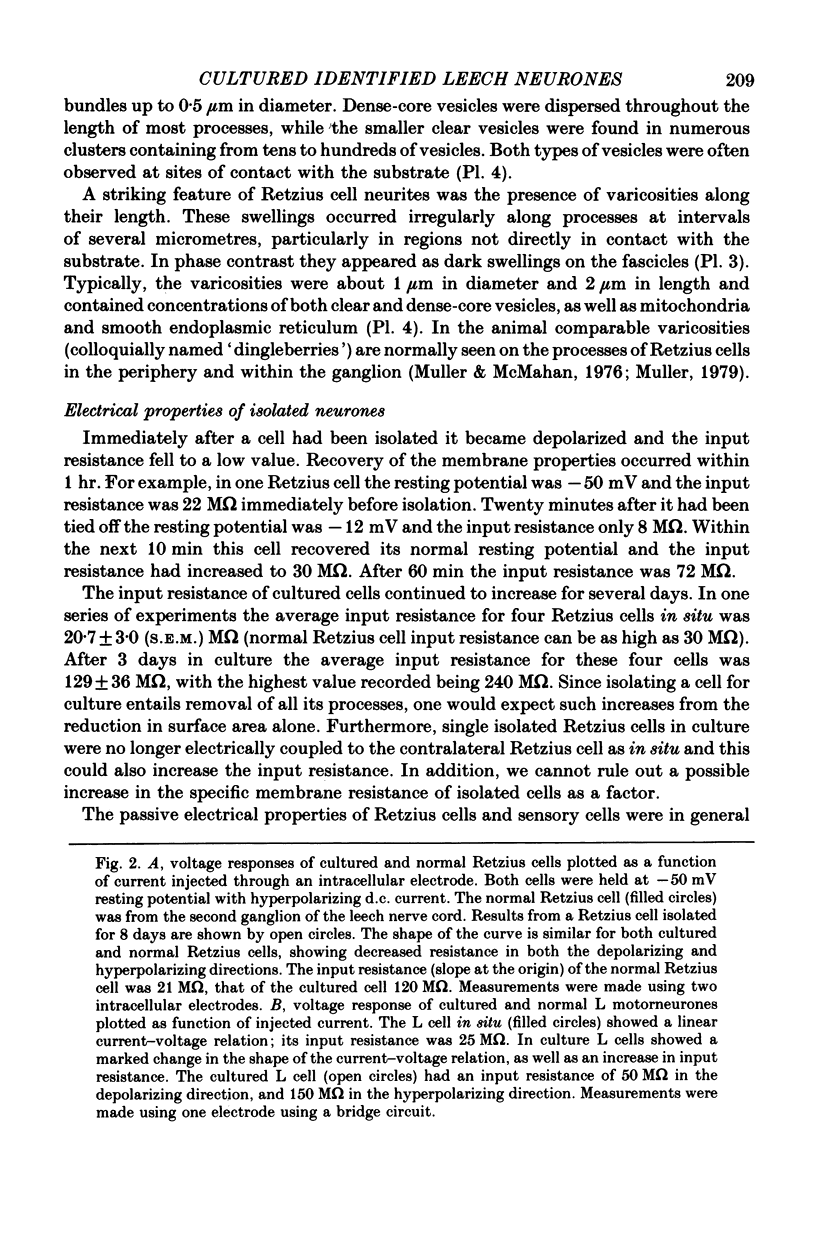
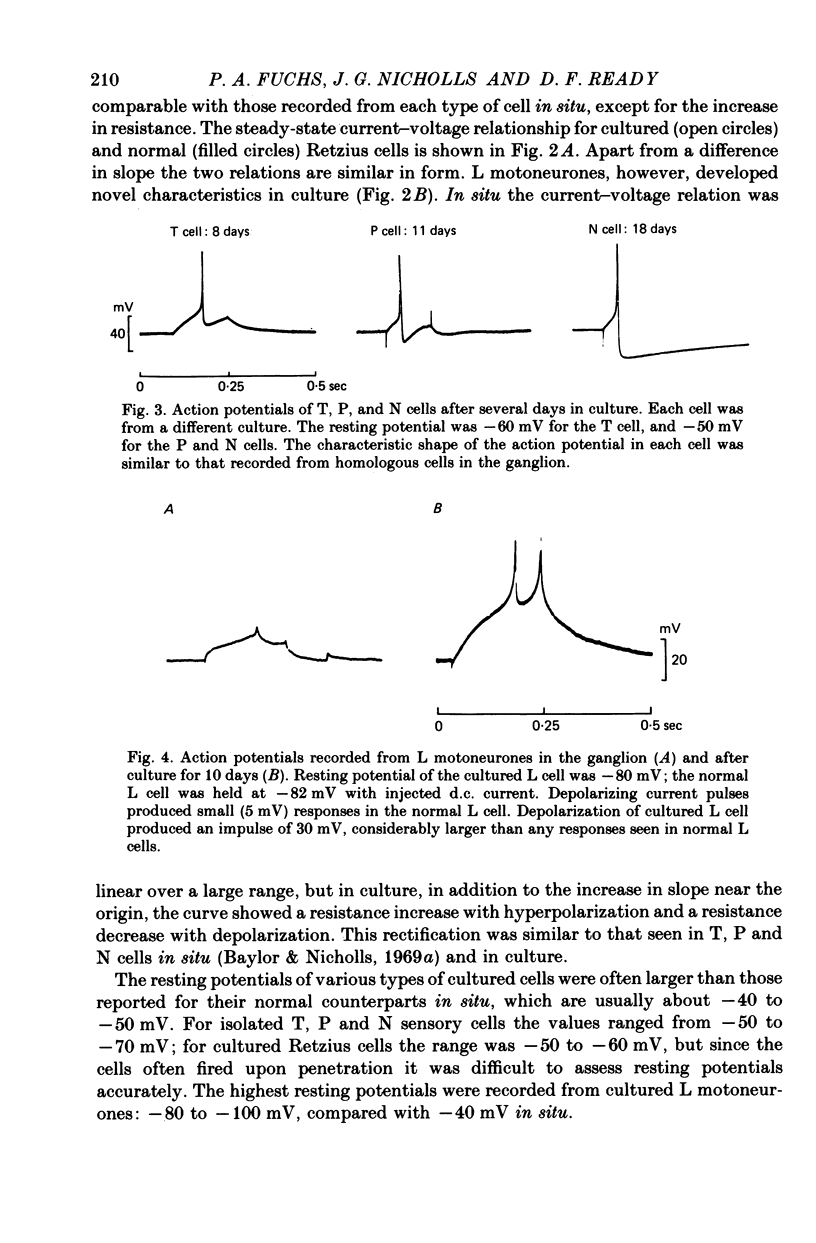
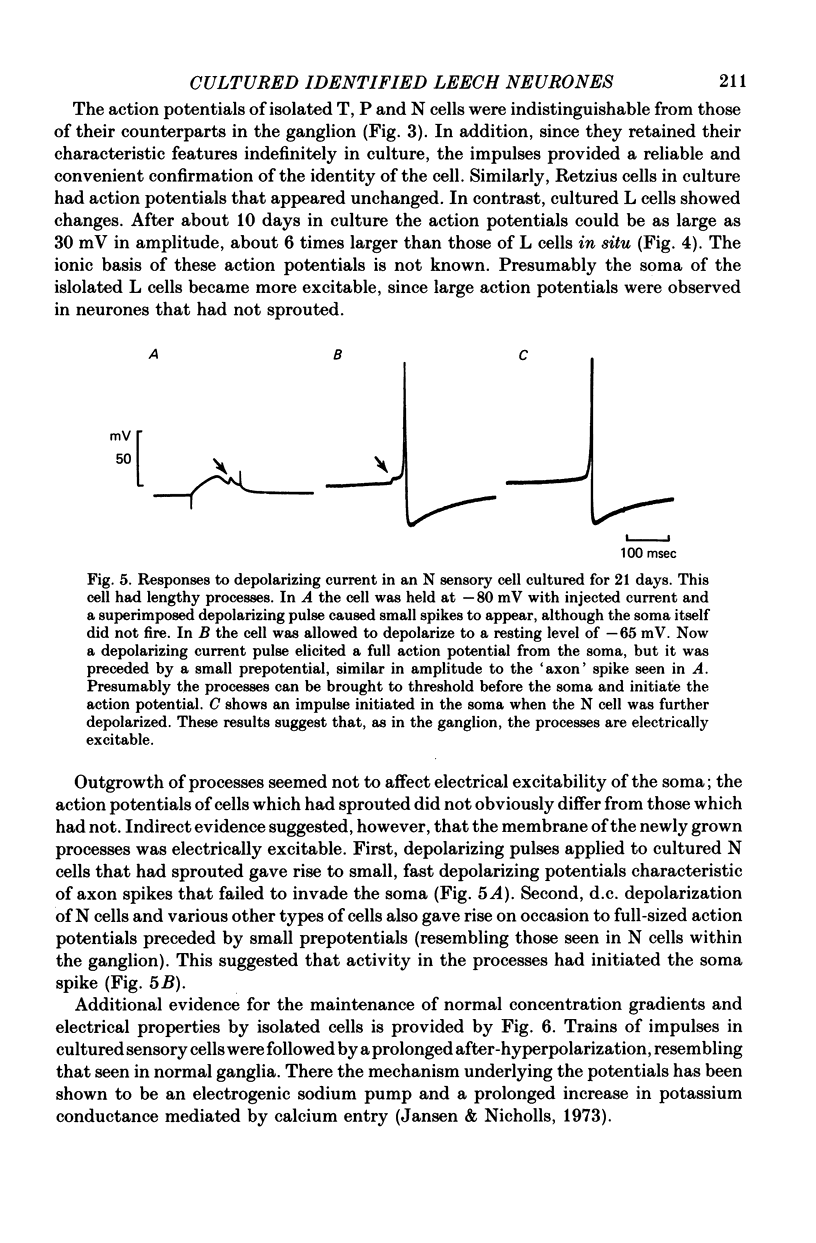
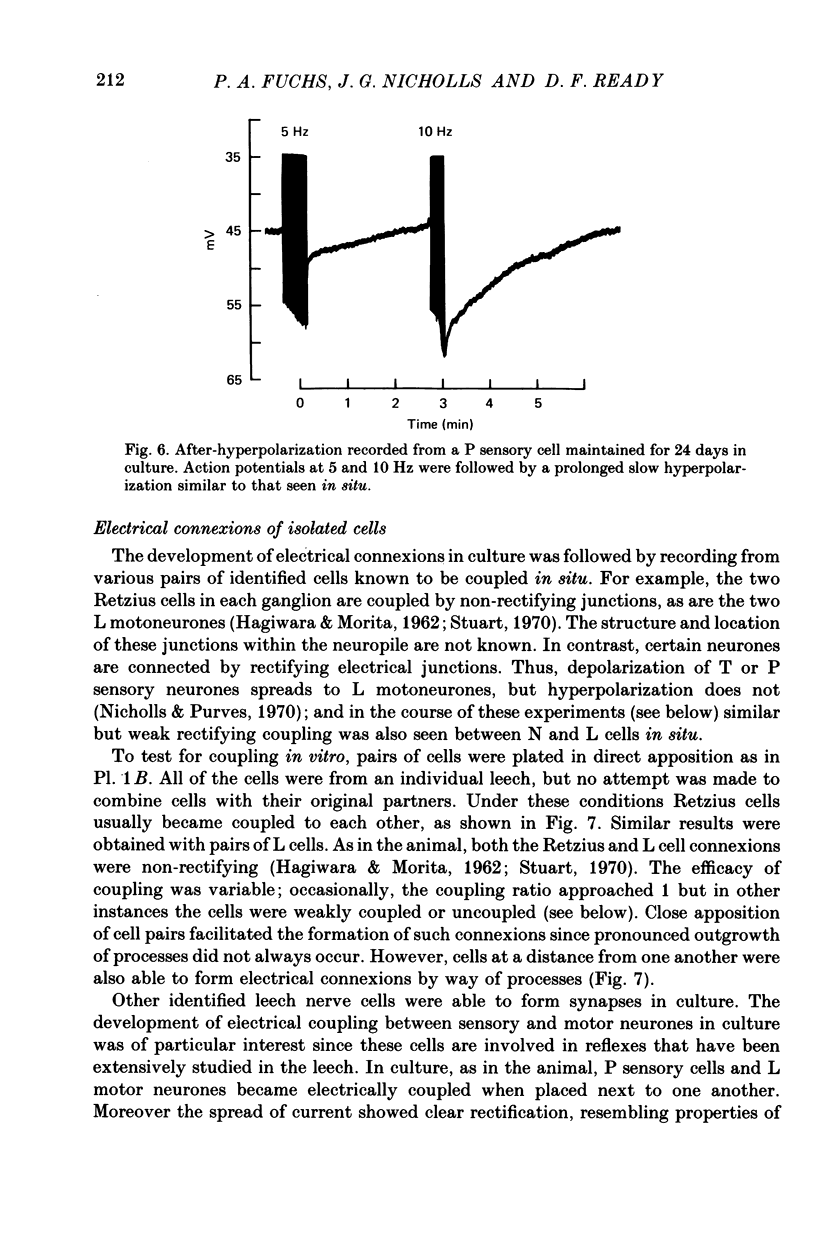
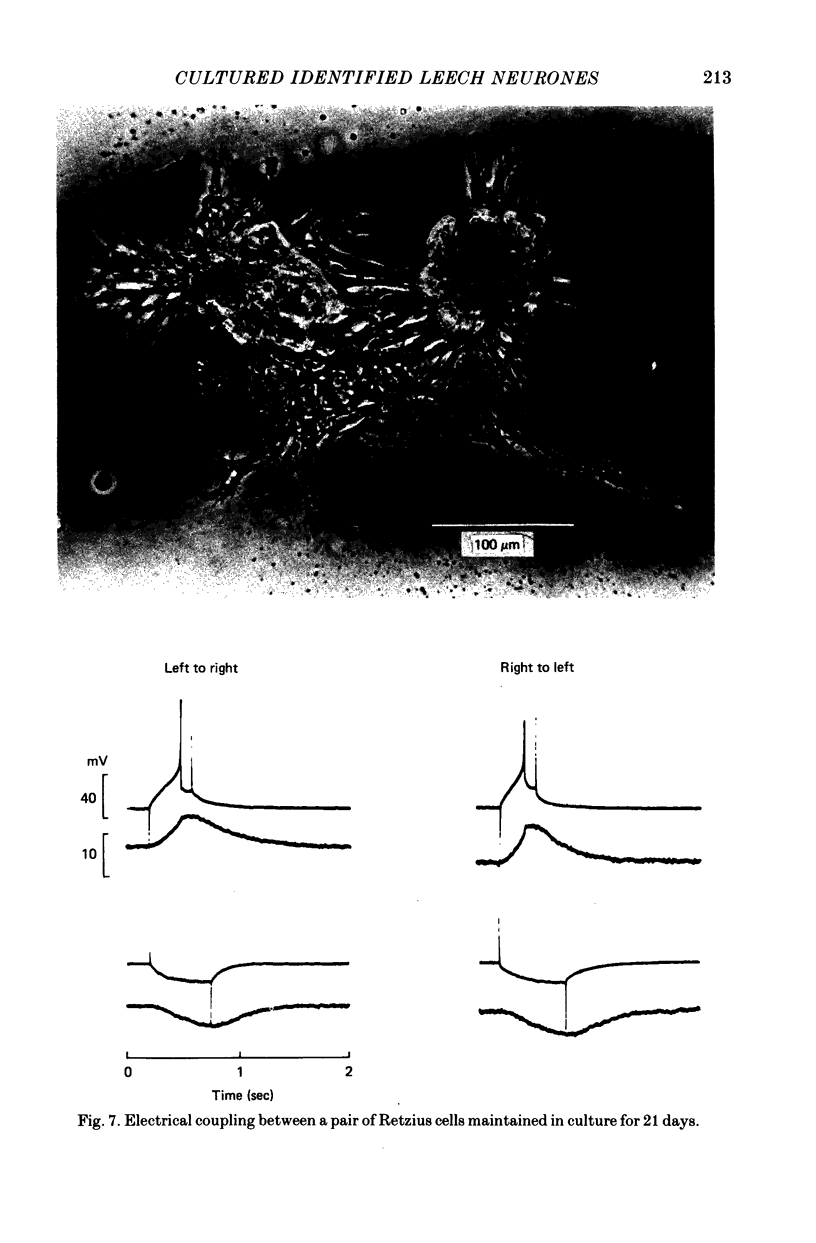
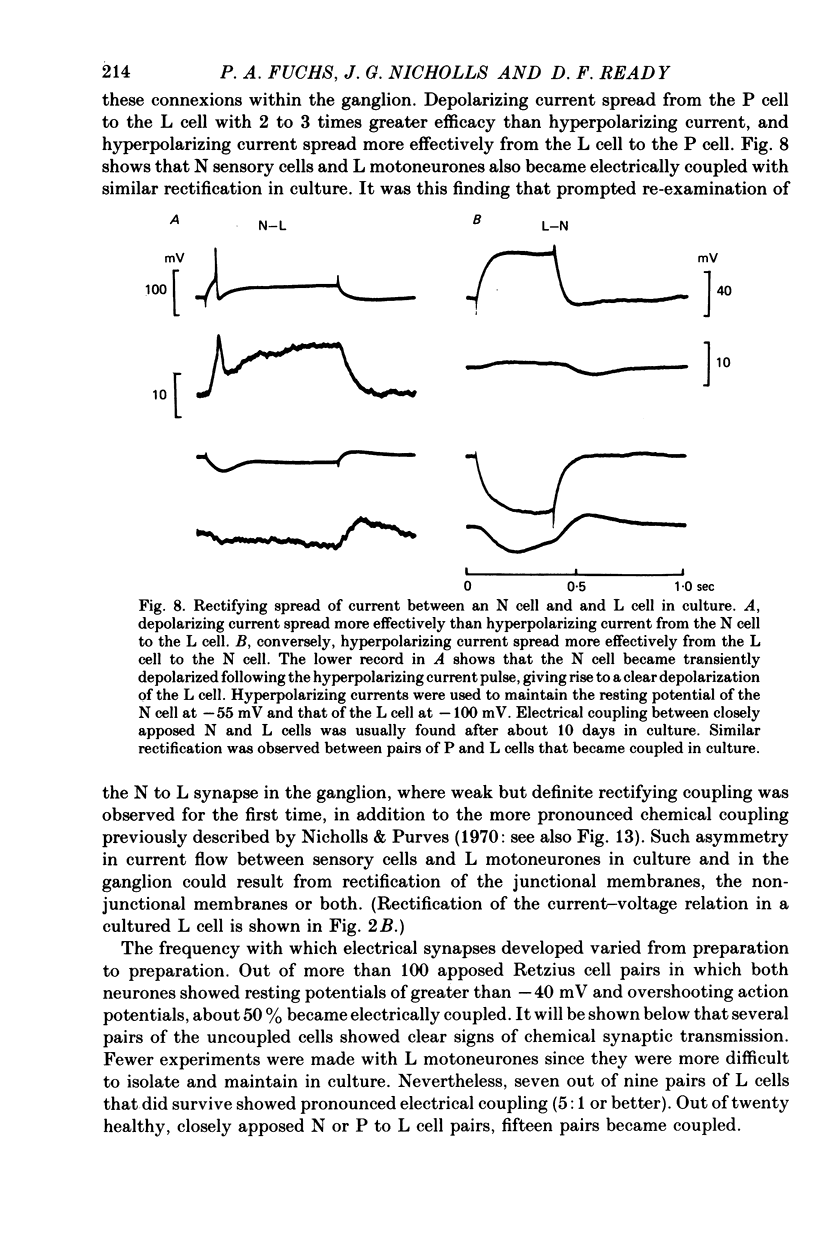
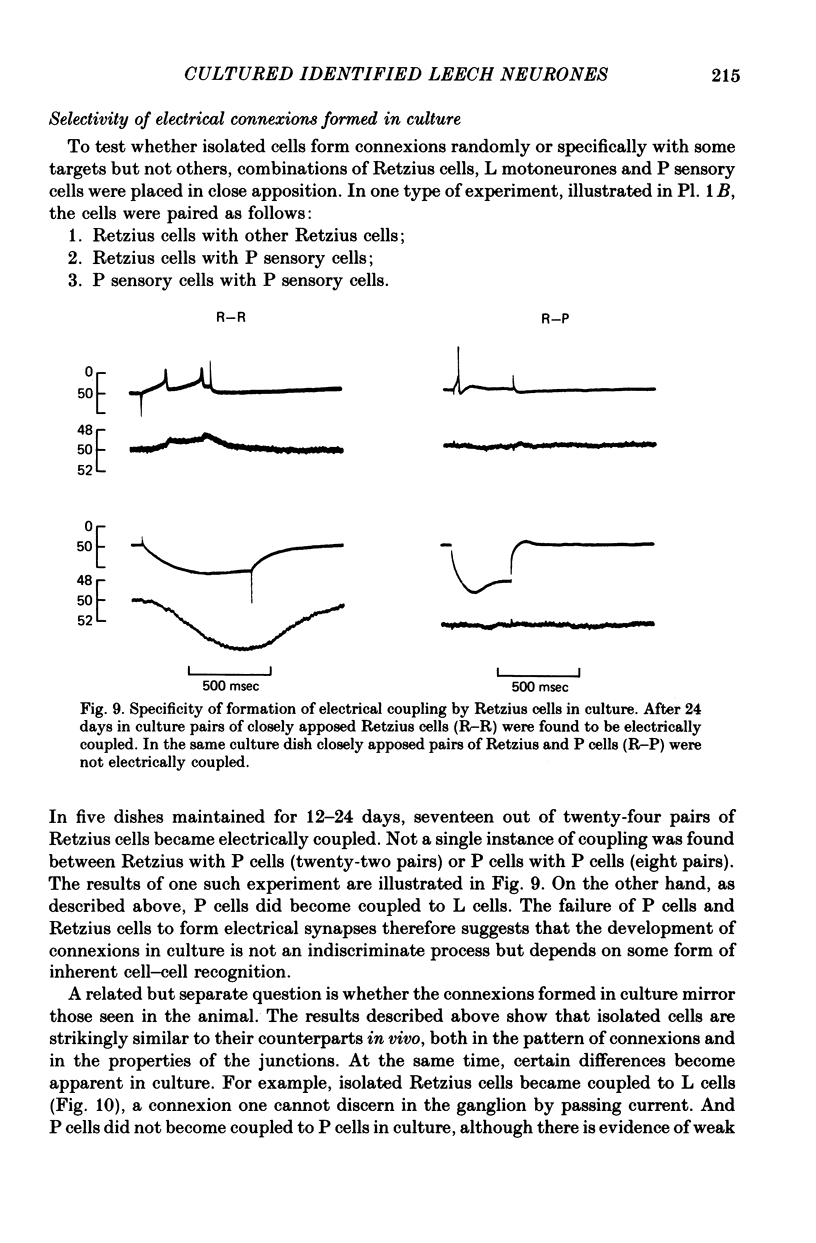
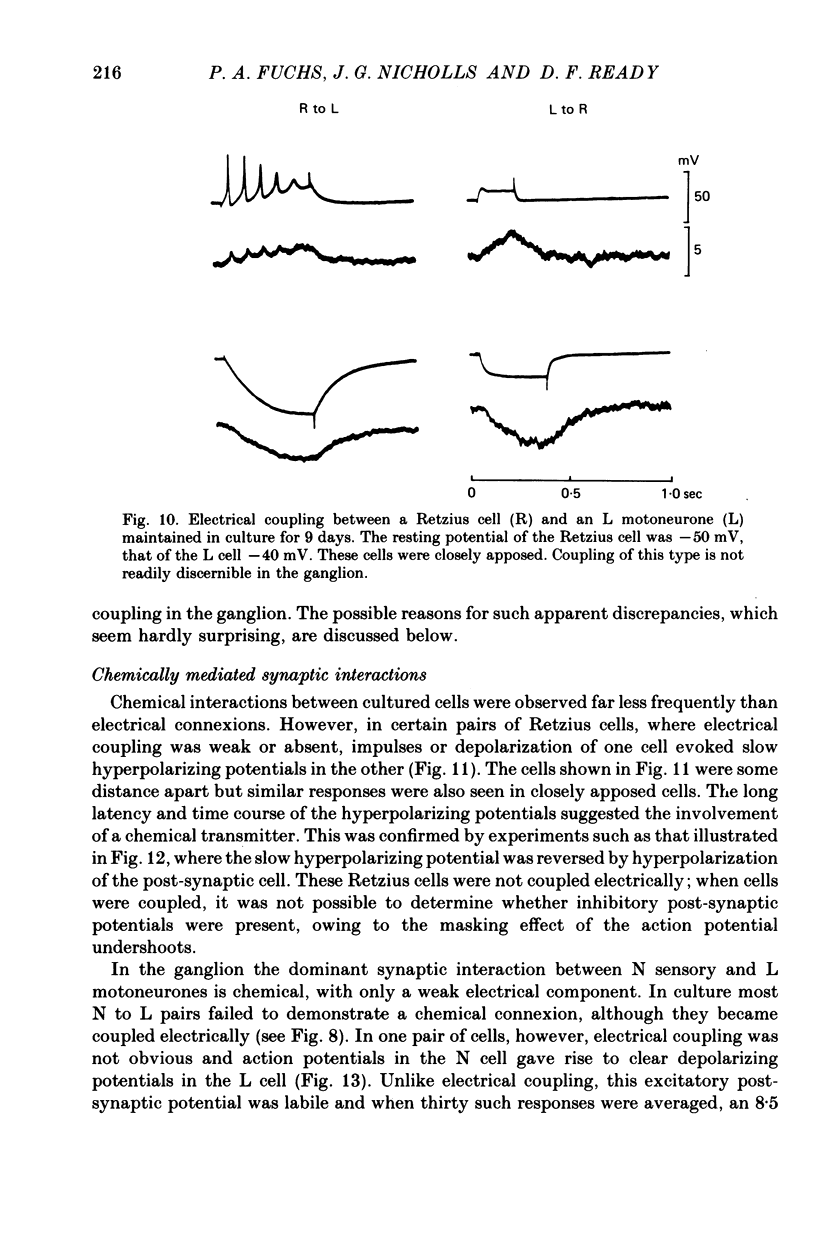
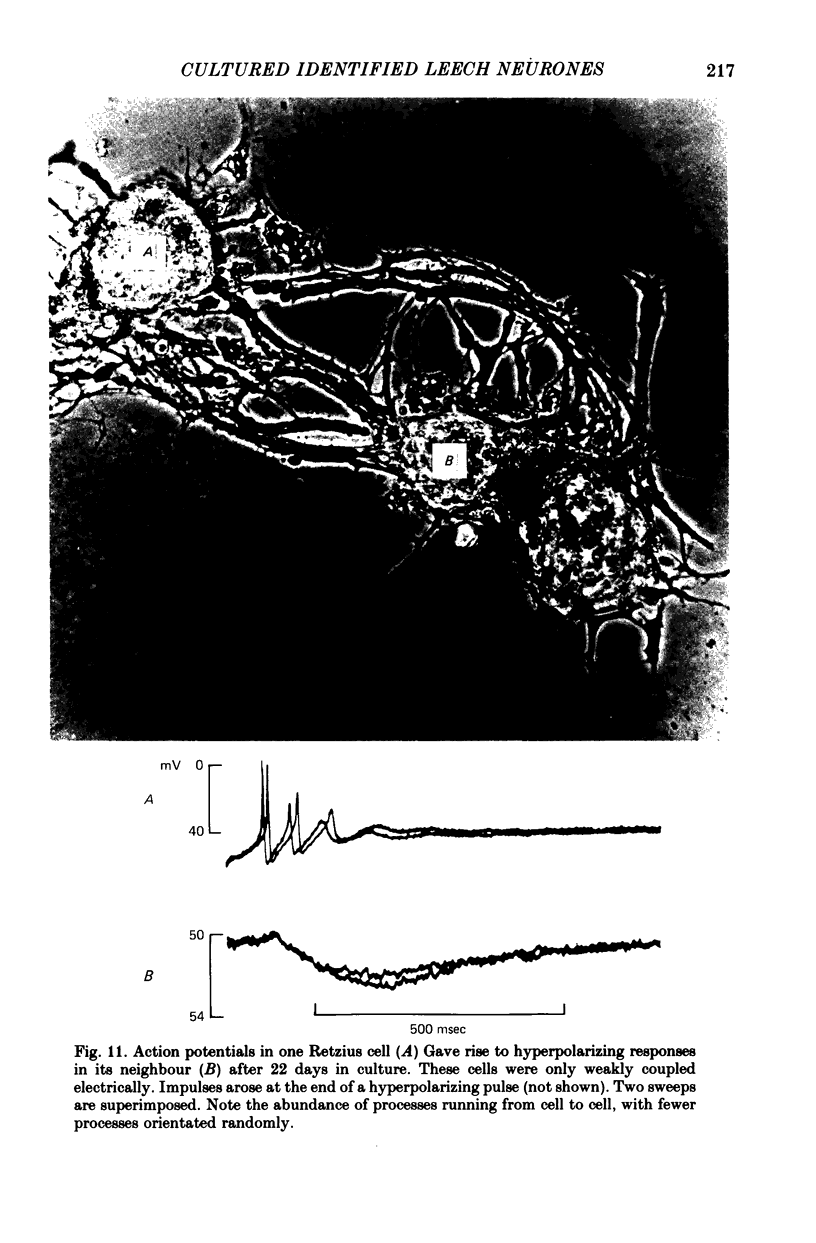
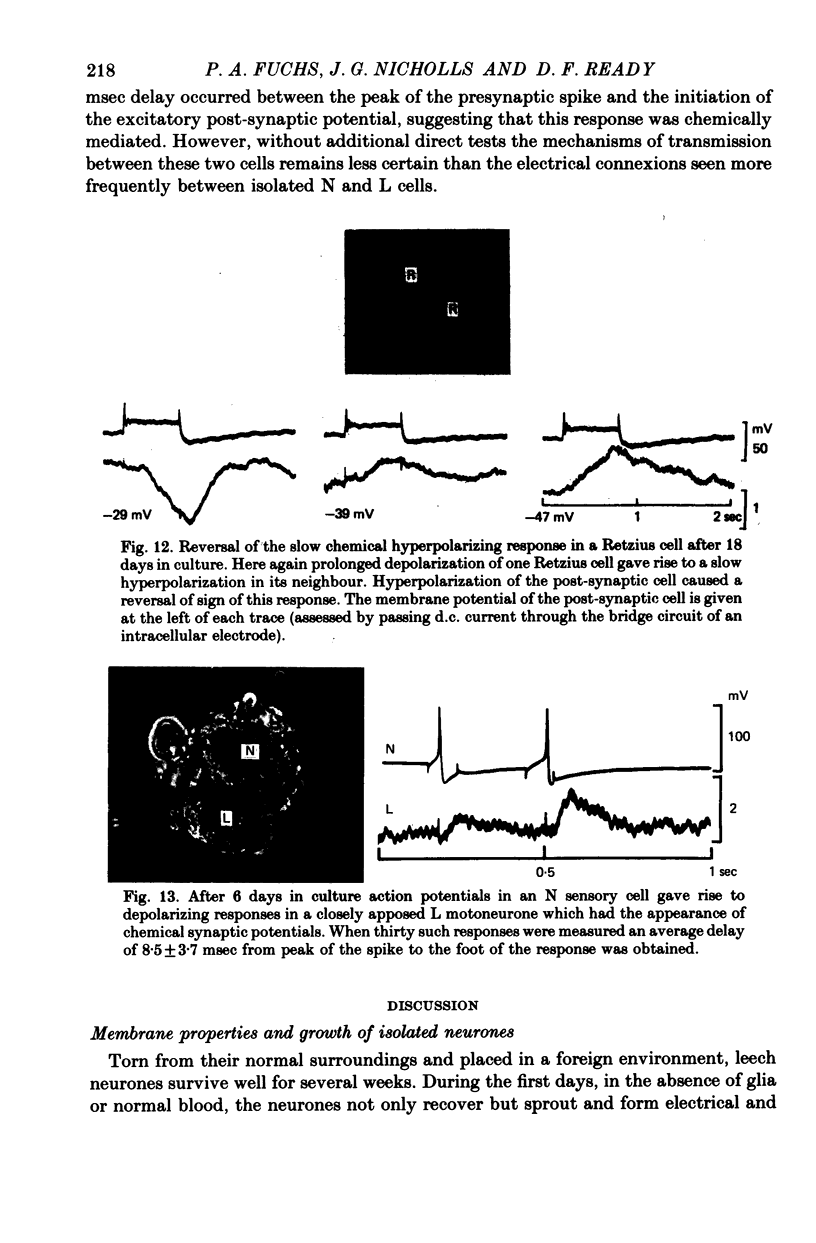
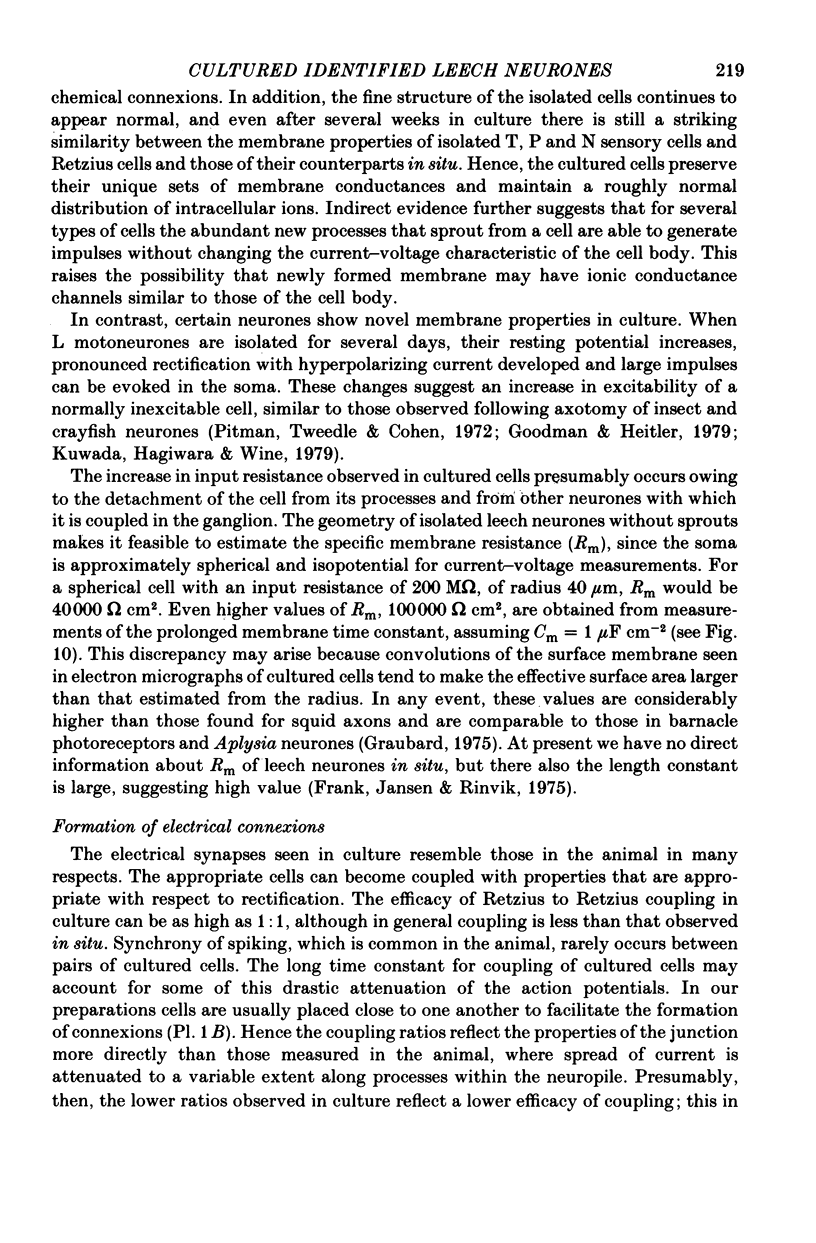
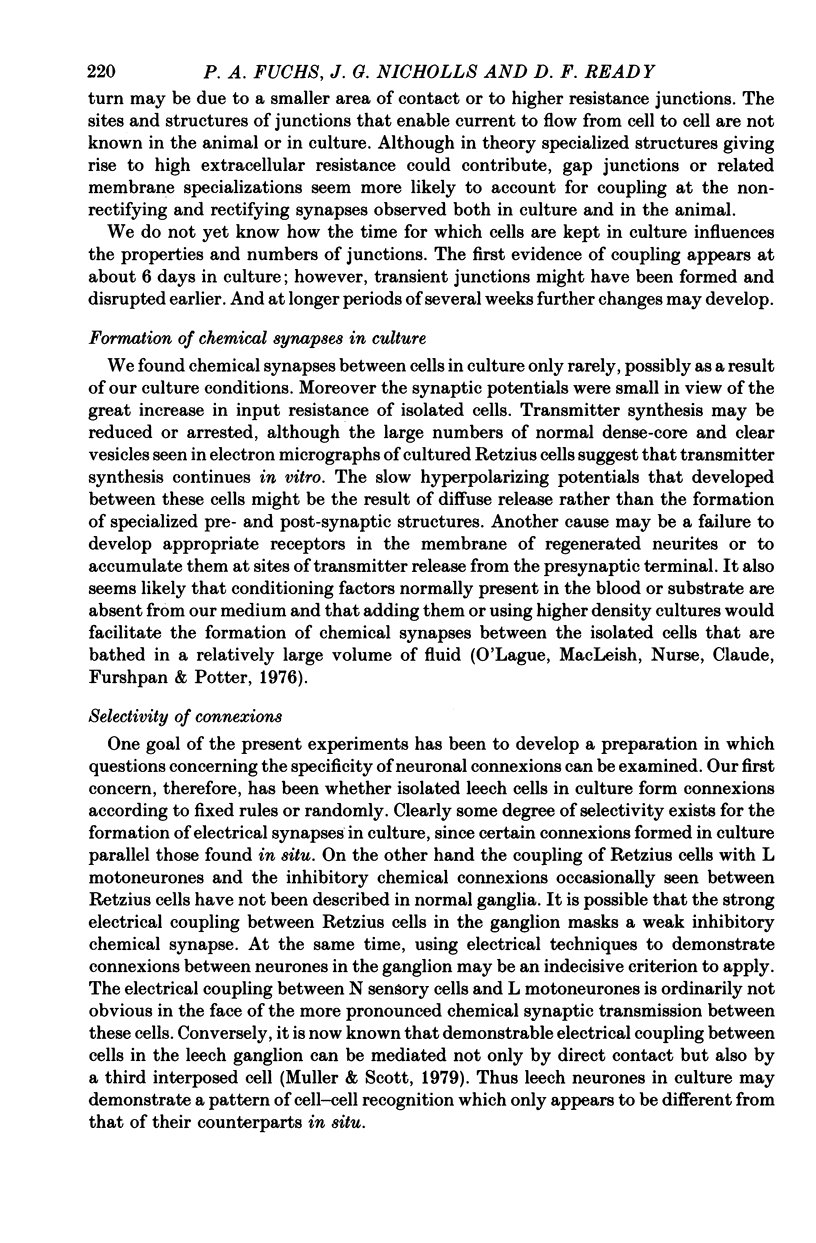
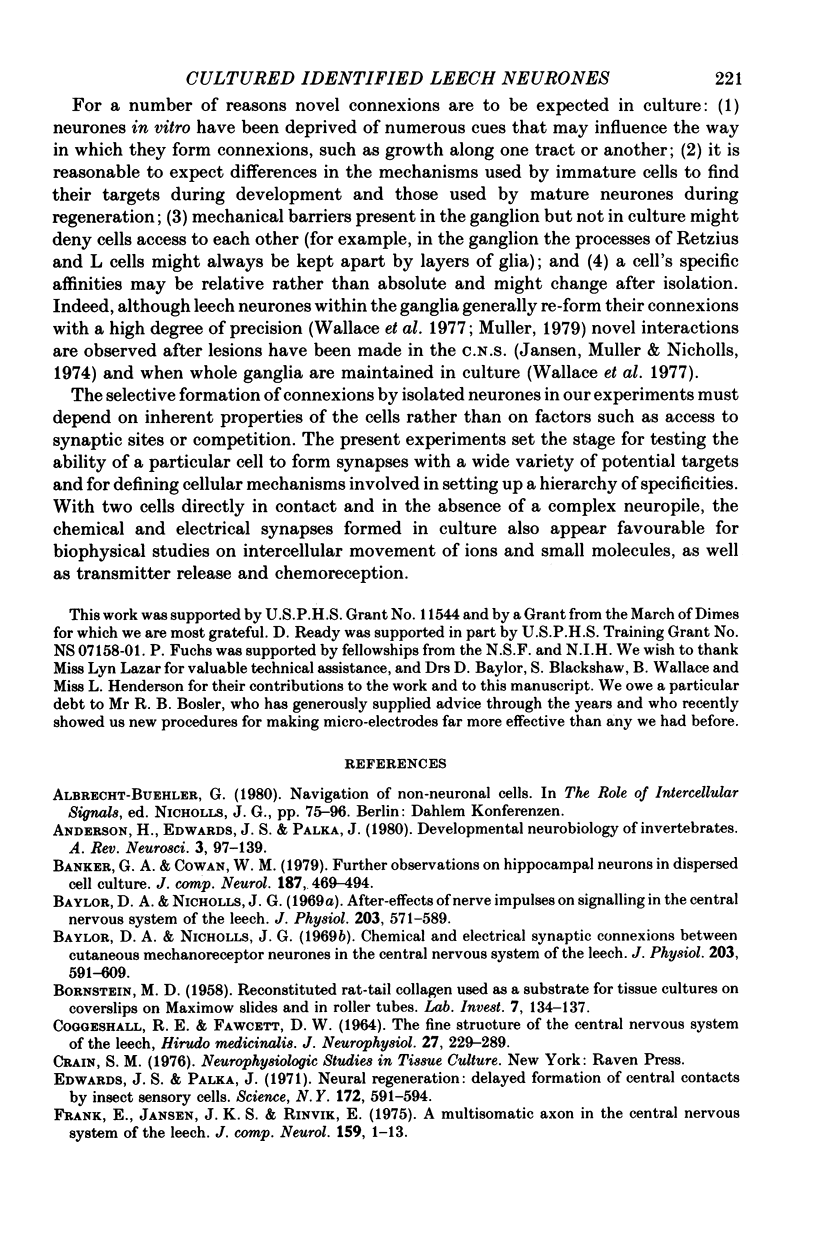
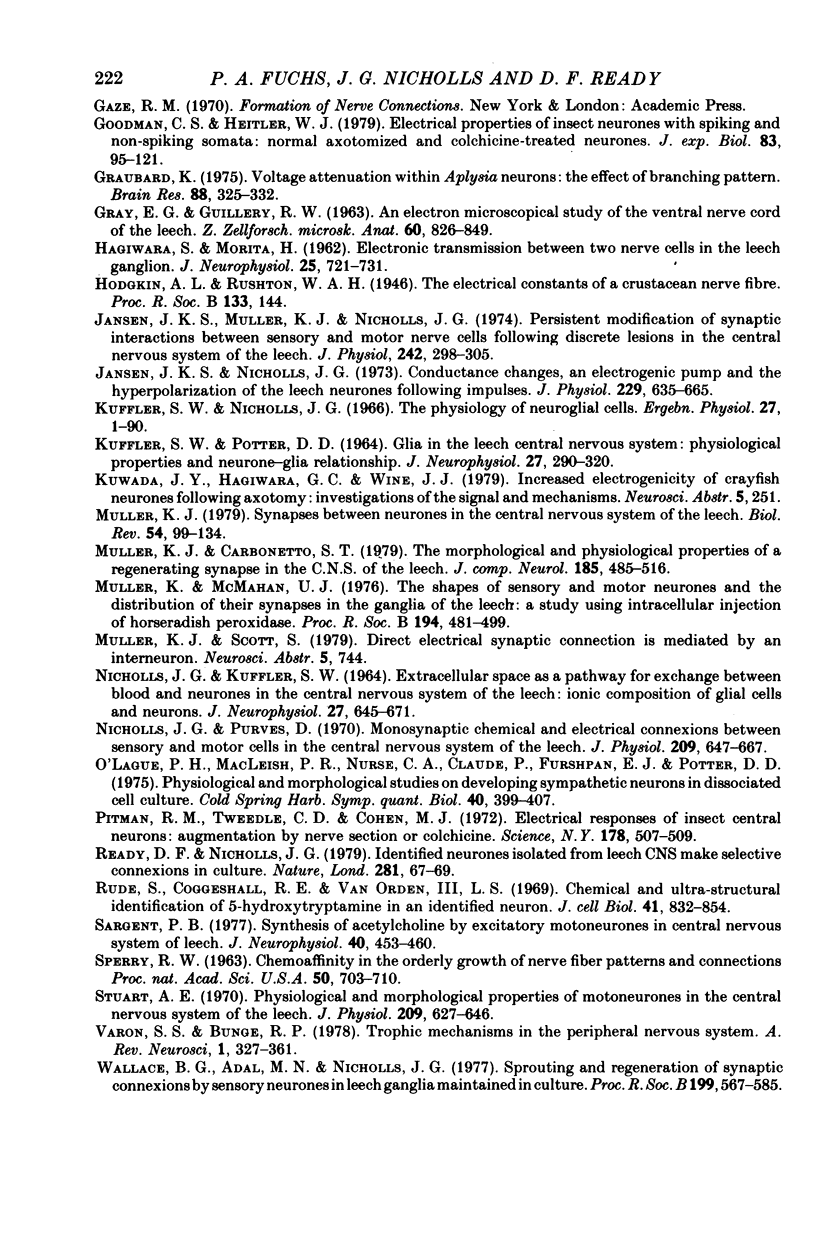
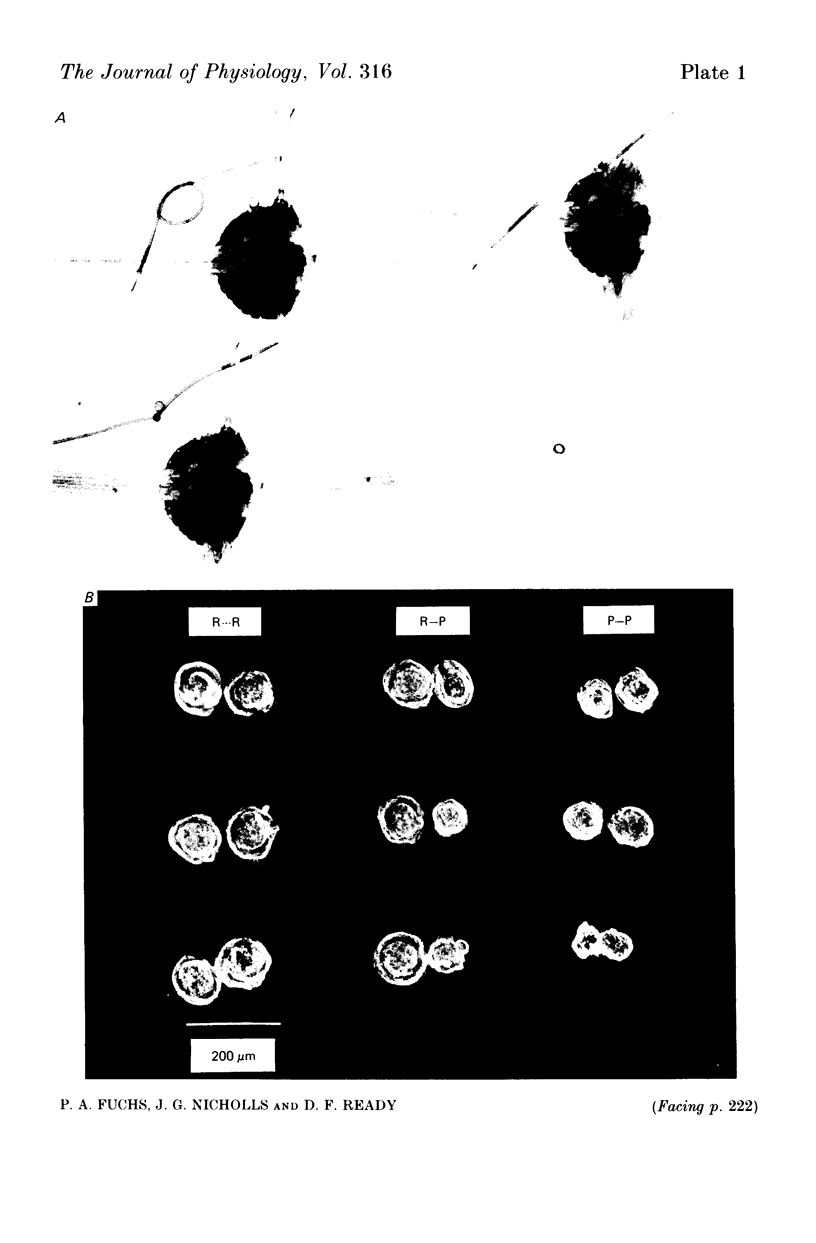
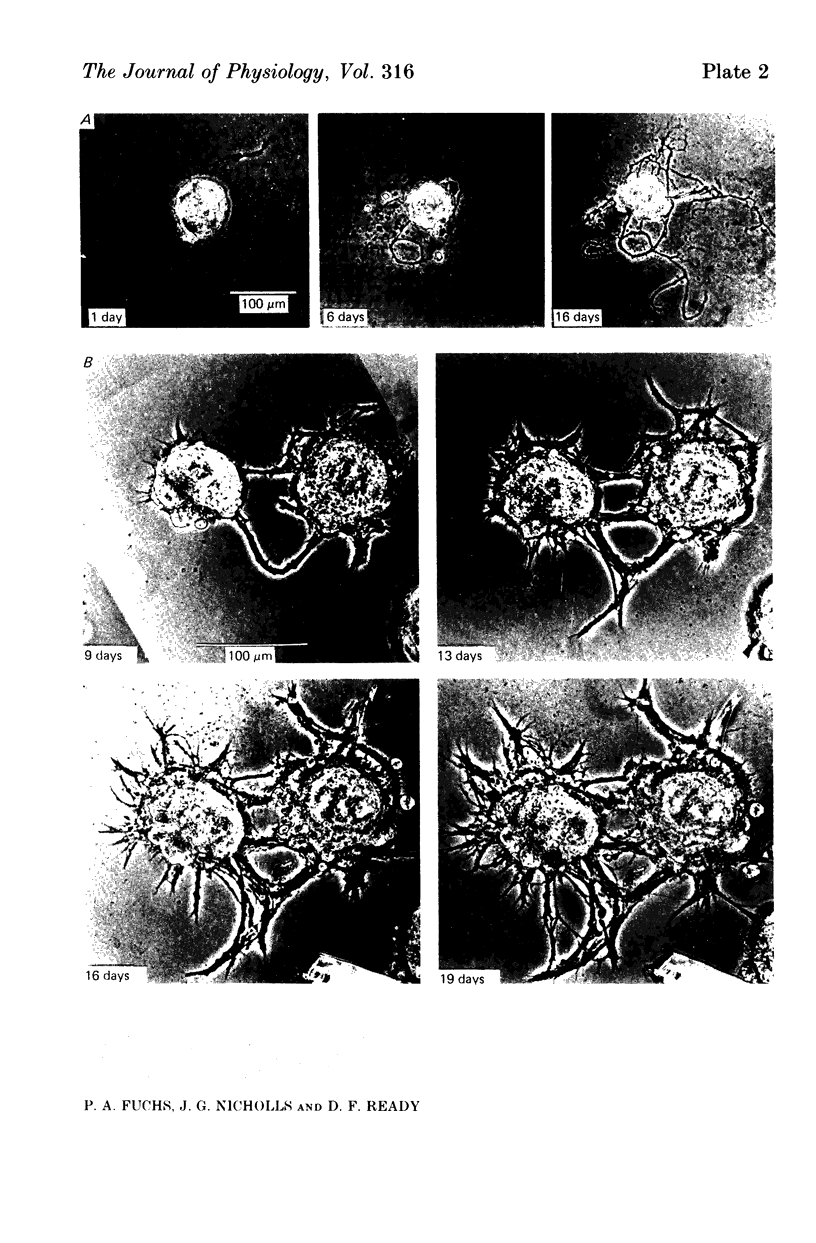
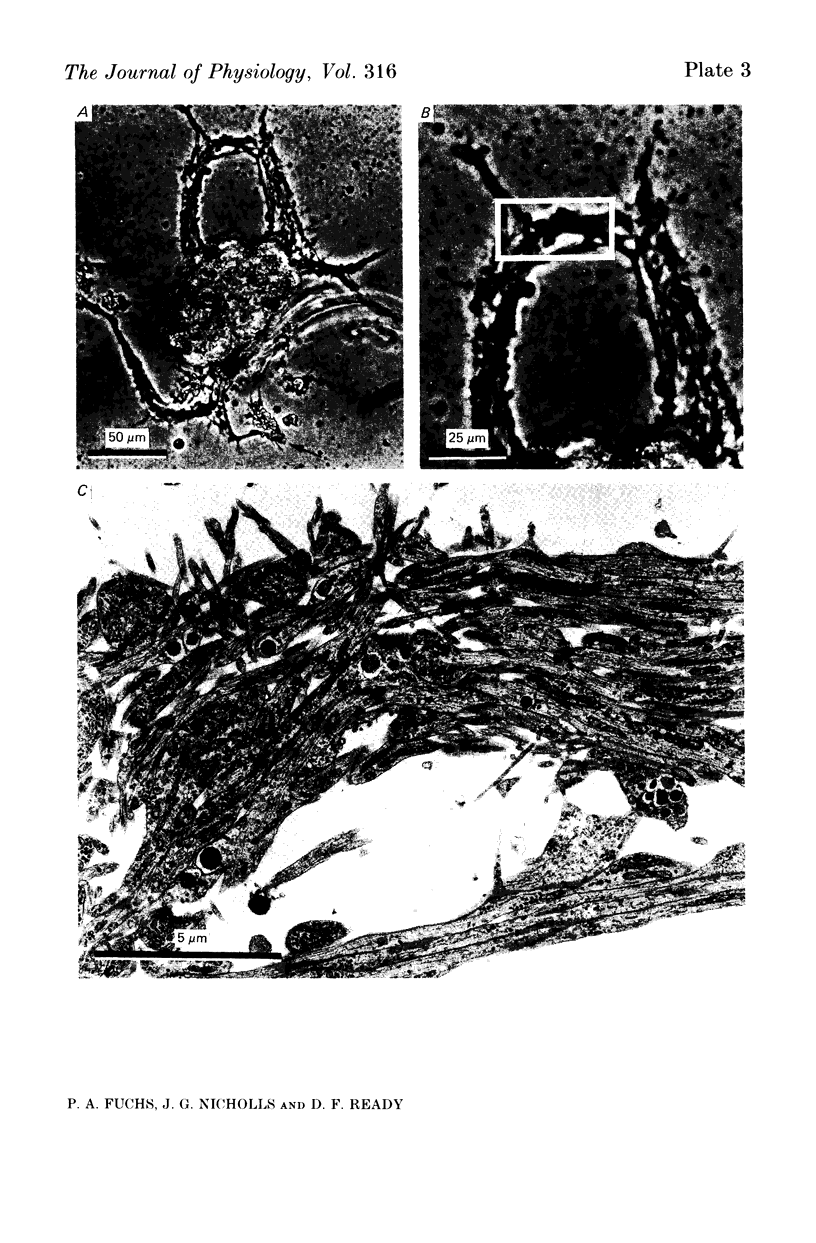
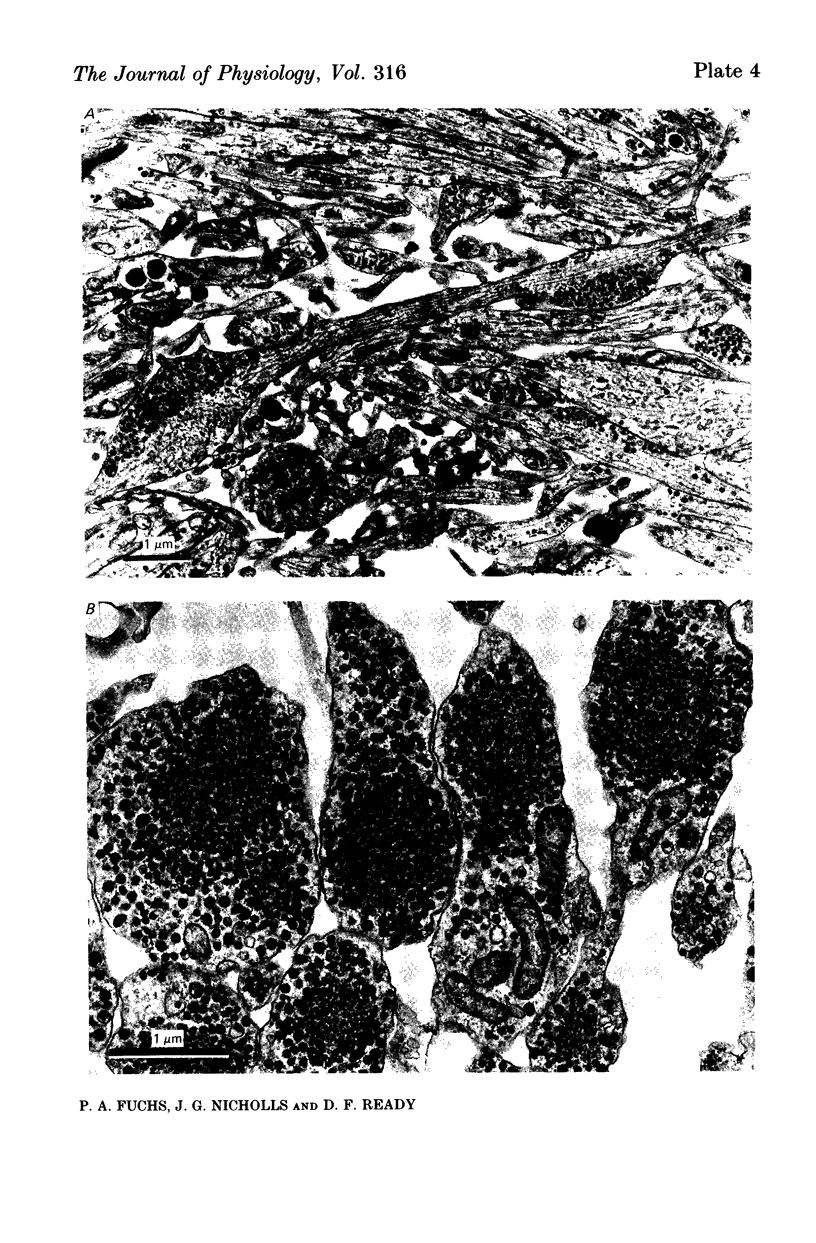
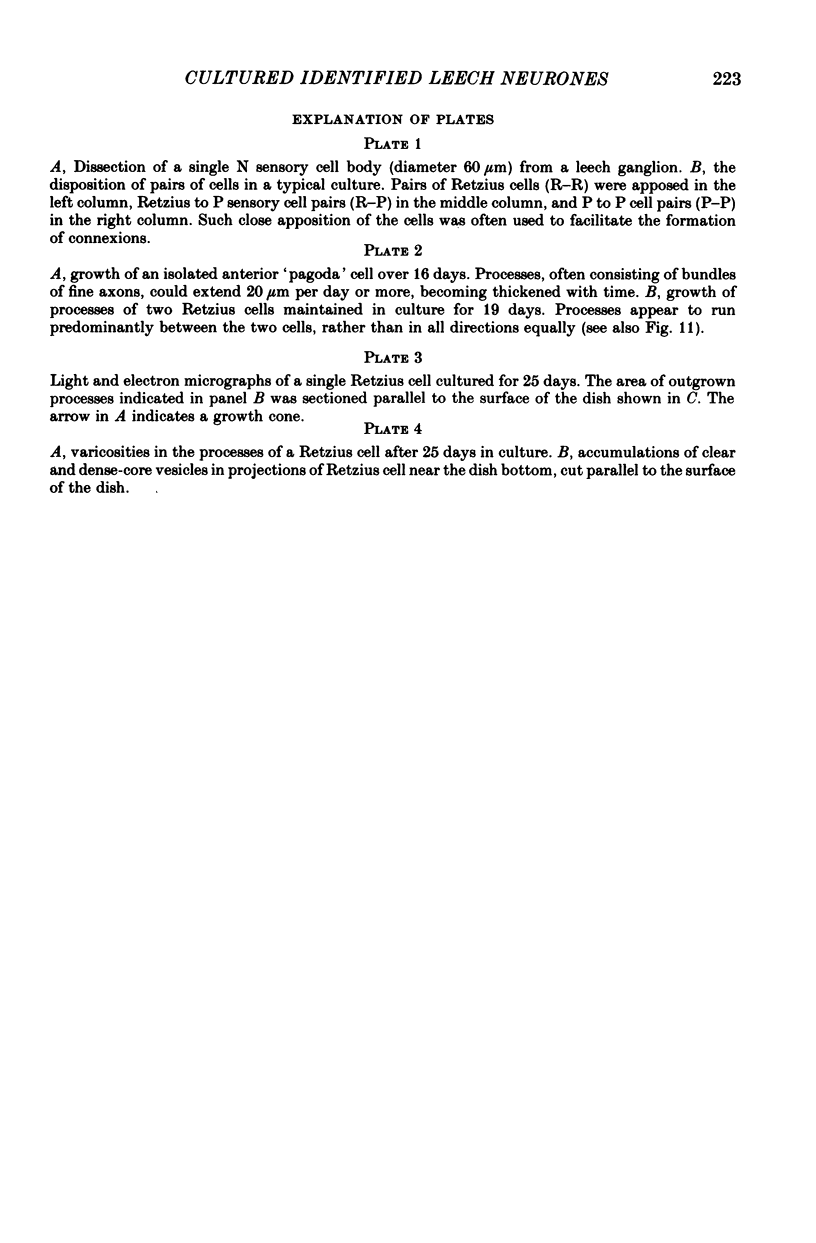
Images in this article
Selected References
These references are in PubMed. This may not be the complete list of references from this article.
- Anderson H., Edwards J. S., Palka J. Developmental neurobiology of invertebrates. Annu Rev Neurosci. 1980;3:97–139. doi: 10.1146/annurev.ne.03.030180.000525. [DOI] [PubMed] [Google Scholar]
- BORNSTEIN M. B. Reconstituted rattail collagen used as substrate for tissue cultures on coverslips in Maximow slides and roller tubes. Lab Invest. 1958 Mar-Apr;7(2):134–137. [PubMed] [Google Scholar]
- Banker G. A., Cowan W. M. Further observations on hippocampal neurons in dispersed cell culture. J Comp Neurol. 1979 Oct 1;187(3):469–493. doi: 10.1002/cne.901870302. [DOI] [PubMed] [Google Scholar]
- Baylor D. A., Nicholls J. G. After-effects of nerve impulses on signalling in the central nervous system of the leech. J Physiol. 1969 Aug;203(3):571–589. doi: 10.1113/jphysiol.1969.sp008880. [DOI] [PMC free article] [PubMed] [Google Scholar]
- Baylor D. A., Nicholls J. G. Chemical and electrical synaptic connexions between cutaneous mechanoreceptor neurones in the central nervous system of the leech. J Physiol. 1969 Aug;203(3):591–609. doi: 10.1113/jphysiol.1969.sp008881. [DOI] [PMC free article] [PubMed] [Google Scholar]
- COGGESHALL R. E., FAWCETT D. W. THE FINE STRUCTURE OF THE CENTRAL NERVOUS SYSTEM OF THE LEECH, HIRUDO MEDICINALIS. J Neurophysiol. 1964 Mar;27:229–289. doi: 10.1152/jn.1964.27.2.229. [DOI] [PubMed] [Google Scholar]
- Edwards J. S., Palka J. Neural regeneration: delayed formation of central contacts by insect sensory cells. Science. 1971 May 7;172(3983):591–594. doi: 10.1126/science.172.3983.591. [DOI] [PubMed] [Google Scholar]
- Frank E., Jansen J. K., Rinvik E. A multisomatic axon in the central nervous system of the leech. J Comp Neurol. 1975 Jan 1;159(1):1–13. doi: 10.1002/cne.901590102. [DOI] [PubMed] [Google Scholar]
- GRAY E. G., GUILLERY R. W. AN ELECTRON MICROSCOPICAL STUDY OF THE VENTRAL NERVE CORD OF THE LEECH. Z Zellforsch Mikrosk Anat. 1963 Sep 18;60:826–849. doi: 10.1007/BF00339095. [DOI] [PubMed] [Google Scholar]
- Goodman C. S., Heitler W. J. Electrical properties of insect neurones with spiking and non-spiking somata: normal, axotomized, and colchicine-treated neurones. J Exp Biol. 1979 Dec;83:95–121. doi: 10.1242/jeb.83.1.95. [DOI] [PubMed] [Google Scholar]
- Graubard K. Voltage attenuation within Aplysia neurons: the effect of branching pattern. Brain Res. 1975 May 2;88(2):325–332. doi: 10.1016/0006-8993(75)90394-7. [DOI] [PubMed] [Google Scholar]
- HAGIWARA S., MORITA H. Electrotonic transmission between two nerve cells in leech ganglion. J Neurophysiol. 1962 Nov;25:721–731. doi: 10.1152/jn.1962.25.6.721. [DOI] [PubMed] [Google Scholar]
- Jansen J. K., Jr, Muller K. J., Nicholls J. G. Persistent modification of synaptic interactions between sensory and motor nerve cells following discrete lesions in the central nervous system of the leech. J Physiol. 1974 Oct;242(2):289–305. doi: 10.1113/jphysiol.1974.sp010708. [DOI] [PMC free article] [PubMed] [Google Scholar]
- Jansen J. K., Nicholls J. G. Conductance changes, an electrogenic pump and the hyperpolarization of leech neurones following impulses. J Physiol. 1973 Mar;229(3):635–655. doi: 10.1113/jphysiol.1973.sp010158. [DOI] [PMC free article] [PubMed] [Google Scholar]
- KUFFLER S. W., POTTER D. D. GLIA IN THE LEECH CENTRAL NERVOUS SYSTEM: PHYSIOLOGICAL PROPERTIES AND NEURON-GLIA RELATIONSHIP. J Neurophysiol. 1964 Mar;27:290–320. doi: 10.1152/jn.1964.27.2.290. [DOI] [PubMed] [Google Scholar]
- Kuffler S. W., Nicholls J. G. The physiology of neuroglial cells. Ergeb Physiol. 1966;57:1–90. [PubMed] [Google Scholar]
- Muller K. J., Carbonetto S. The morphological and physiological properties of a regenerating synapse in the C.N.S. of the leech. J Comp Neurol. 1979 Jun 1;185(3):485–516. doi: 10.1002/cne.901850305. [DOI] [PubMed] [Google Scholar]
- Muller K. J., McMahan U. J. The shapes of sensory and motor neurones and the distribution of their synapses in ganglia of the leech: a study using intracellular injection of horseradish peroxidase. Proc R Soc Lond B Biol Sci. 1976 Nov 12;194(1117):481–499. doi: 10.1098/rspb.1976.0090. [DOI] [PubMed] [Google Scholar]
- Muller K. J. Synapses between neurones in the central nervous system of the leech. Biol Rev Camb Philos Soc. 1979 May;54(2):99–134. doi: 10.1111/j.1469-185x.1979.tb00869.x. [DOI] [PubMed] [Google Scholar]
- NICHOLLS J. G., KUFFLER S. W. EXTRACELLULAR SPACE AS A PATHWAY FOR EXCHANGE BETWEEN BLOOD AND NEURONS IN THE CENTRAL NERVOUS SYSTEM OF THE LEECH: IONIC COMPOSITION OF GLIAL CELLS AND NEURONS. J Neurophysiol. 1964 Jul;27:645–671. doi: 10.1152/jn.1964.27.4.645. [DOI] [PubMed] [Google Scholar]
- Nicholls J. G., Purves D. Monosynaptic chemical and electrical connexions between sensory and motor cells in the central nervous system of the leech. J Physiol. 1970 Aug;209(3):647–667. doi: 10.1113/jphysiol.1970.sp009184. [DOI] [PMC free article] [PubMed] [Google Scholar]
- O'Lague P. H., MacLeish P. R., Nurse C. A., Claude P., Furshpan E. J., Potter D. D. Physiological and morphological studies on developing sympathetic neurons in dissociated cell culture. Cold Spring Harb Symp Quant Biol. 1976;40:399–407. doi: 10.1101/sqb.1976.040.01.038. [DOI] [PubMed] [Google Scholar]
- Pitman R. M., Tweedle C. D., Cohen M. J. Electrical responses of insect central neurons: augmentation by nerve section or colchicine. Science. 1972 Nov 3;178(4060):507–509. doi: 10.1126/science.178.4060.507. [DOI] [PubMed] [Google Scholar]
- Ready D. F., Nicholls J. Identified neurones isolated from leech CNS make selective connections in culture. Nature. 1979 Sep 6;281(5726):67–69. doi: 10.1038/281067a0. [DOI] [PubMed] [Google Scholar]
- Rude S., Coggeshall E., Van Orden L. S., 3rd Chemical and ultrastructural identification of 5-hydroxytryptamine in an identified neuron. J Cell Biol. 1969 Jun;41(3):832–854. doi: 10.1083/jcb.41.3.832. [DOI] [PMC free article] [PubMed] [Google Scholar]
- SPERRY R. W. CHEMOAFFINITY IN THE ORDERLY GROWTH OF NERVE FIBER PATTERNS AND CONNECTIONS. Proc Natl Acad Sci U S A. 1963 Oct;50:703–710. doi: 10.1073/pnas.50.4.703. [DOI] [PMC free article] [PubMed] [Google Scholar]
- Sargent P. B. Synthesis of acetylcholine by excitatory motoneurons in central nervous system of the leech. J Neurophysiol. 1977 Mar;40(2):453–460. doi: 10.1152/jn.1977.40.2.453. [DOI] [PubMed] [Google Scholar]
- Stuart A. E. Physiological and morphological properties of motoneurones in the central nervous system of the leech. J Physiol. 1970 Aug;209(3):627–646. doi: 10.1113/jphysiol.1970.sp009183. [DOI] [PMC free article] [PubMed] [Google Scholar]
- Varon S. S., Bunge R. P. Trophic mechanisms in the peripheral nervous system. Annu Rev Neurosci. 1978;1:327–361. doi: 10.1146/annurev.ne.01.030178.001551. [DOI] [PubMed] [Google Scholar]
- Wallace B. G., Adal M. N., Nicholls J. G. Regeneration of synaptic connections by sensory neurons in leech ganglia maintained in culture. Proc R Soc Lond B Biol Sci. 1977 Dec 30;199(1137):567–585. doi: 10.1098/rspb.1977.0164. [DOI] [PubMed] [Google Scholar]



